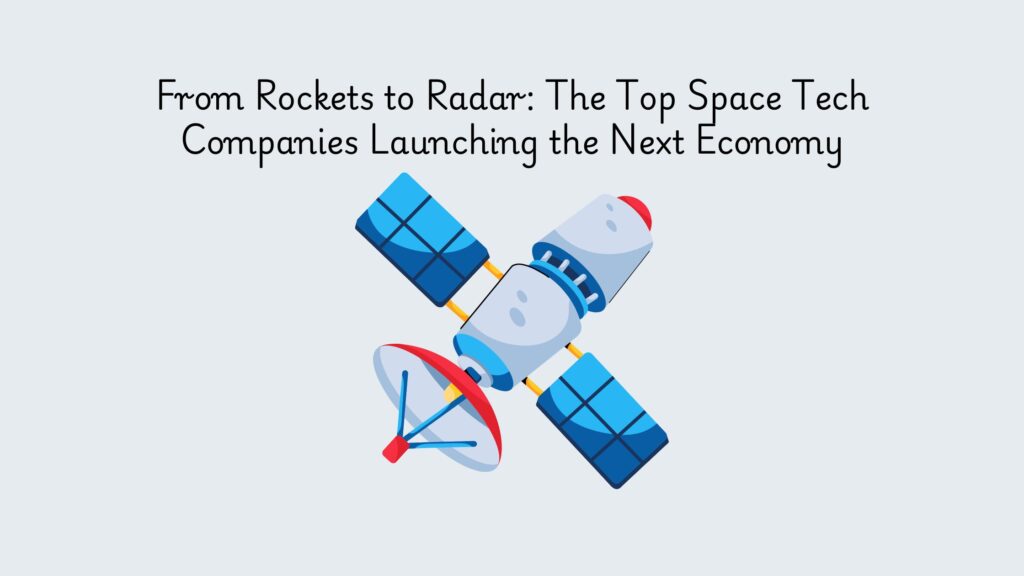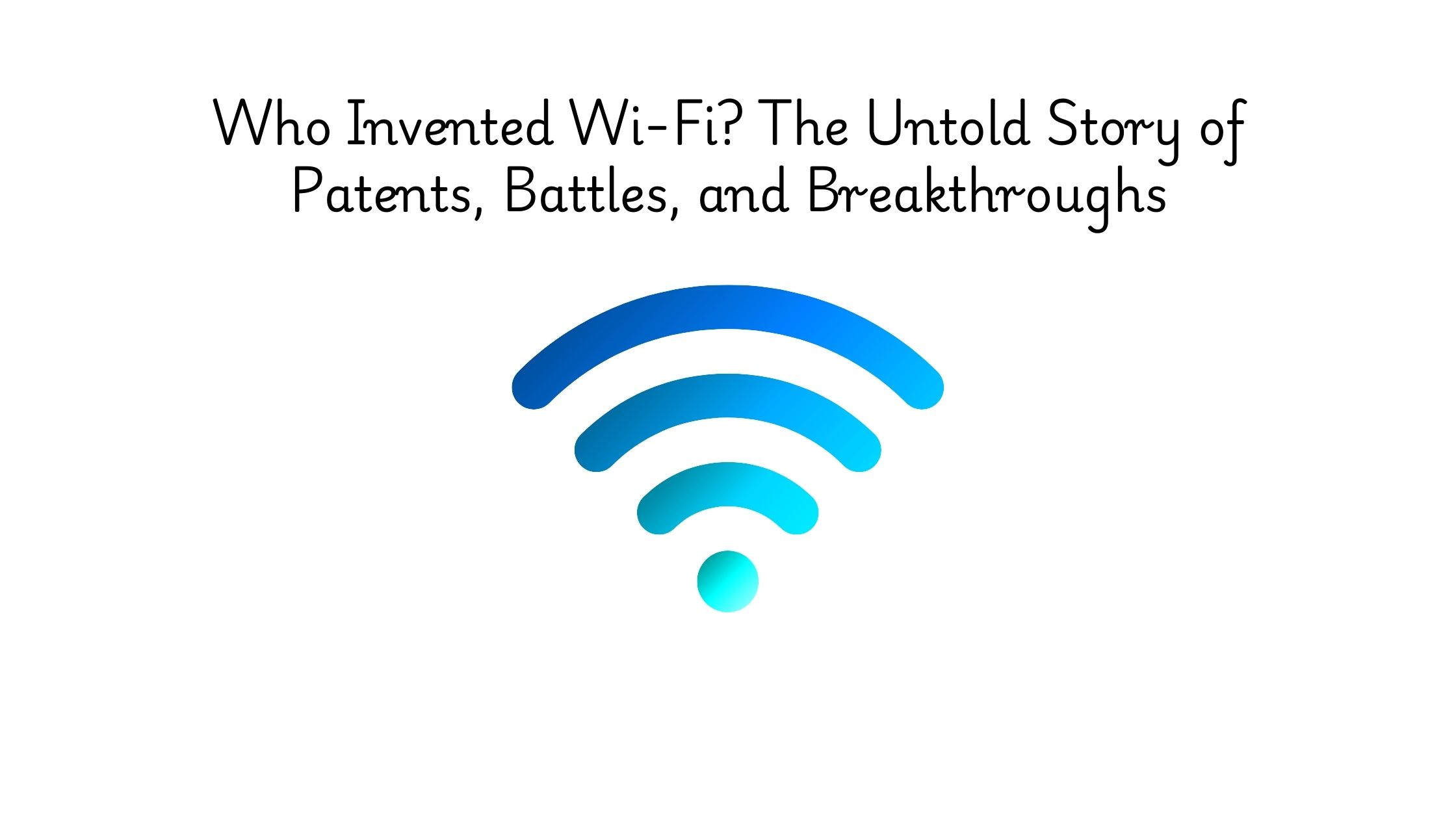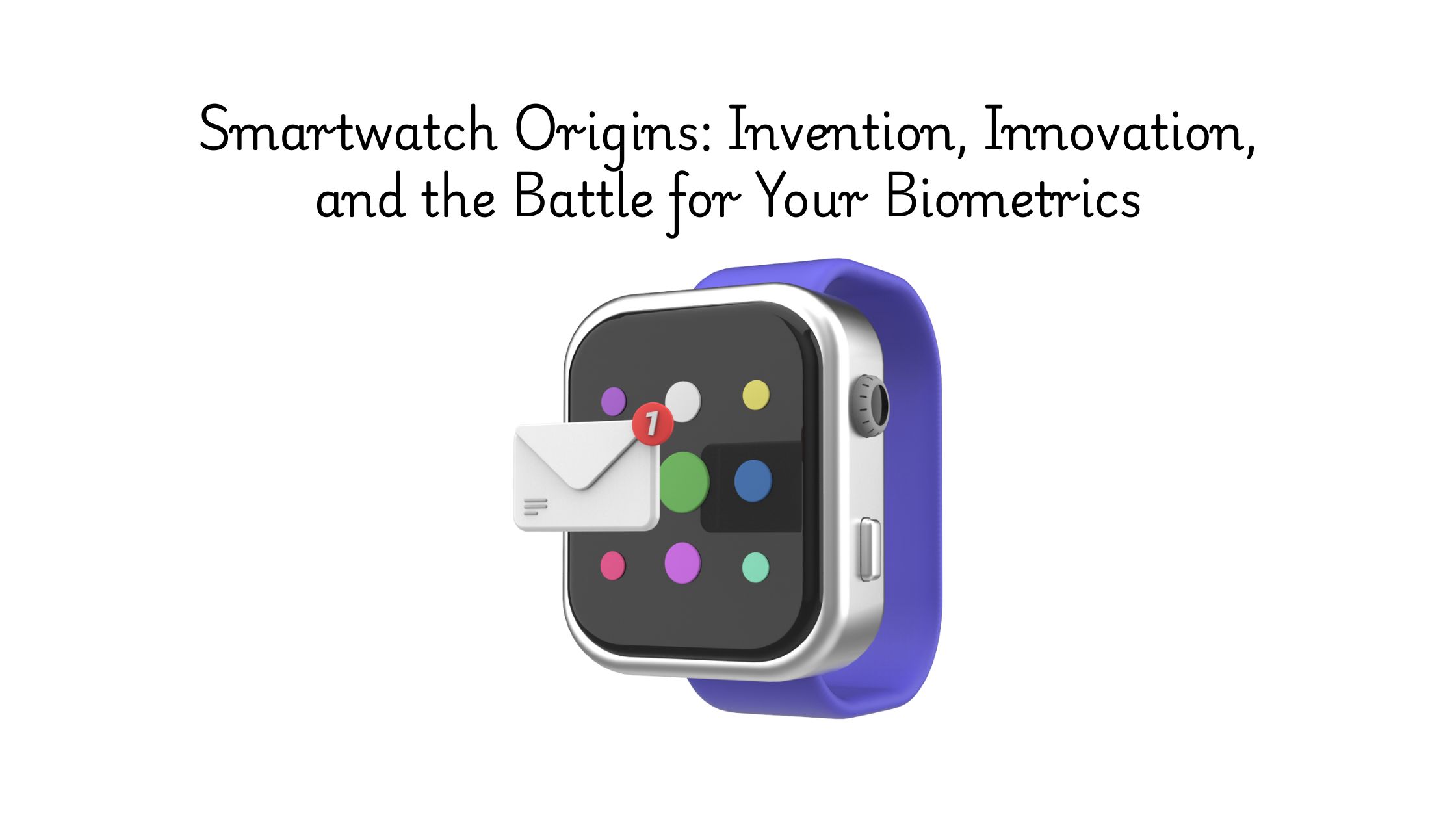The final frontier isn’t just for governments anymore. Space is now a business, and the companies winning aren’t just launching rockets. They’re locking in patents, building proprietary tech, and reshaping entire industries from orbit.
A 2024 report by McKinsey and the World Economic Forum says it all: The global space economy is on track to explode from $630 billion to $1.8 trillion by 2035. That’s 9% annual growth, nearly double the global GDP.
In this article, we spotlight the 10 top space tech companies driving that transformation. These are the players filing high-impact patents, building proprietary platforms, launching spacecraft, and reshaping the economics of space.
If you want to see where the future of space is being built, read on.
#1. SpaceX
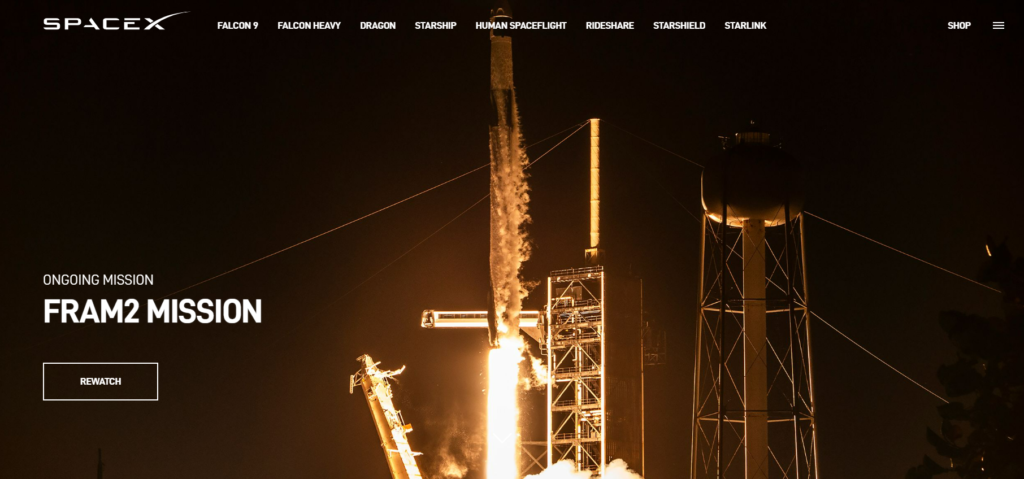
Source: SpaceX
Founded by Elon Musk in 2002, SpaceX is the most dominant force in commercial spaceflight. It broke NASA’s monopoly on crewed launches, pioneered reusable rocket technology, and leads the world in orbital launch frequency. In 2024, SpaceX completed 138 missions, a 40% increase from the previous year, accounting for over half of all global rocket launches.
Its Starship program aims to send humans to Mars, while Starlink, with over 6,000 satellites in orbit as of early 2025, is reshaping internet infrastructure globally. (Starlink Progress Report, 2025).
Industry Impact
SpaceX has fundamentally shifted space from government-controlled to commercially scalable. By vertically integrating everything- engines, satellites, launchpads, software- it has become a space infrastructure company. It is now a critical enabler across telecom, military surveillance, interplanetary science, space-based logistics, and AI-powered satellite networks.
Key Innovations
1. Starship (Block 2 and Block 3 Upgrades)
Starship is the world’s largest and most powerful reusable rocket system. Block 2, tested in 2024, introduced a slimmer forward flap, increased propellant volume, and improved interstage venting. Block 3, now in production, targets a reusable payload capacity of 200+ tons to orbit, which would double the scale of any existing launch vehicle.
Raptor is a methalox full-flow staged combustion engine, a design so complex that no other country has yet flown it. Built for rapid reuse and Mars fuel compatibility, Raptor engines are optimized for both deep space and Earth-based reuse.
3. Starlink V2 Mini Satellites
In 2024, SpaceX began mass deployment of Starlink V2 Mini satellites, each with higher bandwidth, better heat rejection, and more powerful onboard propulsion. These satellites are capable of laser-based interlinking and can autonomously route data between regions without ground relays. Up to 29 satellites are launched per Falcon 9, maximizing coverage and efficiency.
SpaceX made history in March 2025 by launching the first-ever crewed polar orbital mission. Known as Fram2, it circled both poles and conducted 22 scientific experiments, ranging from human physiology in polar orbital conditions to atmospheric research on auroras. The mission validated crewed LEO operations beyond equatorial paths.
Patent Activity
As of 2024, SpaceX holds approximately 202 patents globally, with 84 granted and over 88% active.
Most of these patents pertain to the Starlink project, emphasizing satellite technologies and communication systems.
Notable Patents
1. Sea Landing of Space Launch Vehicles and Associated Systems and Methods
Patent Number: US8678321B2 – Describes systems for landing and recovering booster stages on sea-based platforms, a foundational concept for reusable rocket technology.
2. Antenna Apparatus
Patent Number: D1061486 – Details design aspects of antenna systems likely related to Starlink’s satellite communication infrastructure.
3. Tilted Earth-Based Antenna Systems and Methods of Tilting for Communication with a Satellite System
Patent Number: 12244399 – Covers methods for adjusting ground-based antennas to maintain optimal communication with orbiting satellites.
#2. Blue Origin
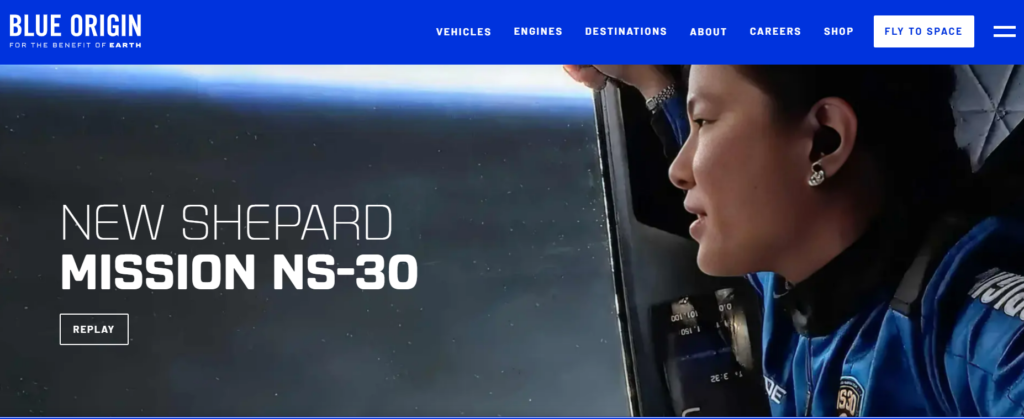
Source: Blue Origin
Founded by Jeff Bezos in 2000, Blue Origin is building an ecosystem for human life beyond Earth. Its motto, Gradatim Ferociter (step by step, ferociously), reflects a long-term vision rather than a fast-paced commercial race. While not as media-visible as SpaceX, Blue Origin is a key NASA partner, a propulsion innovator, and a builder of reusable infrastructure for the Moon and low Earth orbit.
In May 2024, NASA selected Blue Origin to develop the Blue Moon Mark 2 lunar lander, awarding the company $3.4 billion to build a system capable of transporting astronauts and cargo to the Moon’s surface by 2029.
Industry Impact
Blue Origin is driving forward the next phase of sustainable lunar infrastructure and orbital launch systems. It is one of only two companies selected by NASA for human landing systems under Artemis, and its BE-4 engine has become critical to America’s national launch capability, powering both its own New Glenn heavy-lift rocket and ULA’s Vulcan Centaur, which replaced the retired Atlas V.
It’s also developing Orbital Reef, a commercial space station in partnership with Sierra Space and Boeing, envisioned as a successor to the ISS and a platform for microgravity R&D, tourism, and manufacturing.
Key Innovations
1. BE-4 Engine
A reusable, high-thrust liquid oxygen, liquefied natural gas engine. After years of R&D, it was finally launched successfully in 2024. The BE-4 is the first American-made LNG rocket engine and is designed for rapid reusability and high efficiency.
An uncrewed-to-crewed lander platform with a modular design for cargo and human transport. Mark 2 builds on earlier versions with updated avionics, precision landing, and refueling support. NASA plans to use it for Artemis V, scheduled for 2029.
Blue Origin’s upcoming heavy-lift launch system features a 7-meter fairing, reusable first stage, and BE-4 engines. It’s designed to deliver payloads to LEO, GEO, and even cis-lunar orbits. The first orbital launch is expected in 2025.
4. Orbital Reef
A commercial space station in development, featuring modular lab segments, artificial gravity zones, and open access for public and private entities. It aims to serve as a multi-use orbital business park.
Patent Activity
As of 2024, Blue Origin has been granted numerous patents focusing on various aspects of space technology. These patents encompass innovations in vertical landing systems, rocket engine designs, spacecraft assembly, and space debris management.
Notable Patents
1. Sea Landing of Space Launch Vehicles and Associated Systems and Methods
Patent Number: US8678321B2 – Describes methods for landing and recovering a booster stage on a sea-based platform, including vertical powered landing techniques.
2. Thrusting Rails for Launch Vehicles and Associated Systems and Methods
Patent Number: US11987395B2 – Details a thrusting rail system designed to assist in the launch of vehicles, enhancing stability and control during takeoff.
3. Systems and Methods for Securing an Upright Rocket
Patent Number: US12103716B2 – Outlines systems for securing a rocket upright on a movable platform, such as a ship’s landing area, using adjustable cables and telescoping poles.
4. Self-Optimizing Seal for Turbomachinery and Associated Systems and Methods
Patent Number: US12104699B2 – Describes a seal for turbomachinery that adjusts its balance ratio during operation, enhancing performance and efficiency.
These patents reflect Blue Origin’s commitment to advancing space technology through innovative designs and systems aimed at enhancing the safety, efficiency, and reusability of spaceflight operations.
#3. Rocket Lab
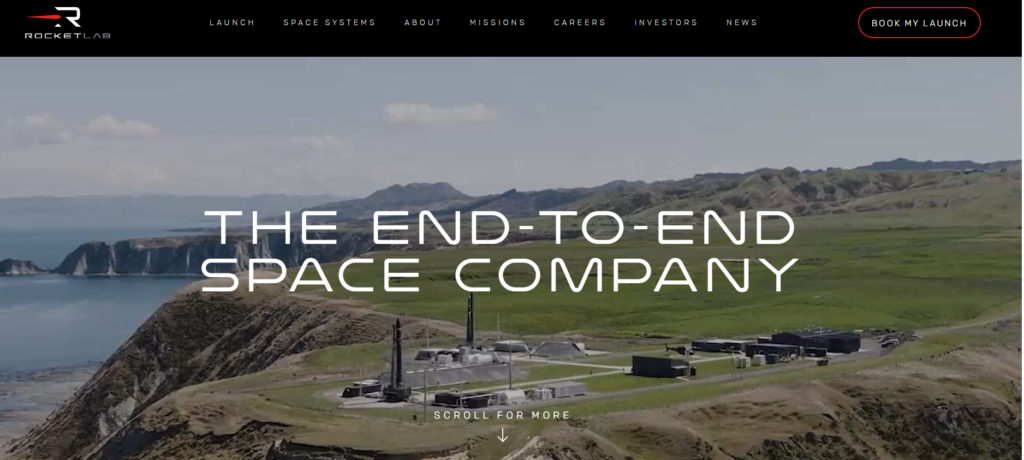
Source: Rocket Lab
Founded in 2006 by Peter Beck, Rocket Lab has emerged as a prominent player in the aerospace industry, specializing in providing comprehensive launch services, spacecraft design and manufacturing, and satellite components. Headquartered in Long Beach, California, the company operates globally, with significant facilities in New Zealand. As of June 2024, Rocket Lab employs approximately 2,000 full-time staff worldwide.
Industry Impact
Rocket Lab has significantly democratized access to space, particularly for small satellite operators. Its flagship launch vehicle, the Electron rocket, is tailored for deploying small payloads into orbit, offering dedicated launches that provide clients with flexibility and control over mission parameters. By February 2025, Rocket Lab had successfully conducted 60 Electron launches, deploying numerous satellites for various applications, including Earth observation, communications, and scientific research.
In addition to commercial endeavors, Rocket Lab has established strong partnerships with U.S. defense and government agencies. Notably, in January 2024, the company secured a $515 million contract to design and build 18 satellites for the U.S. Space Development Agency, underscoring its growing role in national security space initiatives.
Key Innovations
The Electron rocket is Rocket Lab’s flagship small satellite launch vehicle, designed for dedicated missions to low Earth orbit. It has completed numerous successful launches, deploying payloads for various commercial and government customers.
The Neutron rocket is an upcoming medium-lift launch vehicle designed for larger payloads, including satellite constellations and interplanetary missions. It is being developed with reusability in mind, aiming to reduce launch costs and increase launch frequency.
The Photon satellite platform is Rocket Lab’s in-house designed and built spacecraft, offering end-to-end satellite solutions for various missions, from low Earth orbit operations to interplanetary exploration.
The HASTE (Hypersonic Accelerator Suborbital Test Electron) rocket is a suborbital launch vehicle derived from the Electron rocket, tailored for hypersonic technology testing and suborbital research missions.
Patent Activity
Notable Patents
1. Rocket Engine Injector and Thrust Chamber Design
Patent Number: US12196159B1 – This patent details various technologies pertinent to rocket engines, including injectors, thrust chambers, and electrical turbopump devices that may be combined to provide a more efficient rocket engine.
2. Battery Jettison Mechanism for Launch Vehicles
Patent Number: US11408374B1 – This patent describes a system for jettisonable battery systems for use in rocket engine-based launch vehicles. Such systems may feature battery units that are configured to be used to power one or more electric turbopumps that may be used to supply fuel to a rocket engine or engines. One or more of the battery units may be jettisoned during flight in order to reduce weight as they are depleted.
#4. Relativity Space
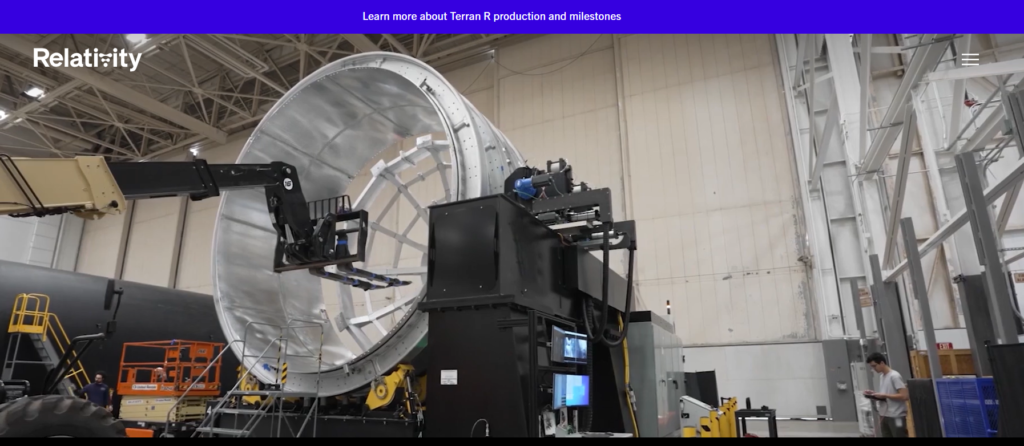
Source:Relativity Space
Founded in 2015 by Tim Ellis and Jordan Noone, Relativity Space is an American aerospace manufacturer headquartered in Long Beach, California. The company aims to revolutionize rocket production by utilizing additive manufacturing (3D printing), artificial intelligence, and autonomous robotics to build reusable rockets. This approach seeks to reduce complexity, lower costs, and accelerate production timelines. In March 2025, former Google CEO Eric Schmidt assumed the role of CEO at Relativity Space, bringing significant financial backing and leadership to the company.
Industry Impact
Relativity Space is redefining the aerospace industry by introducing fully 3D-printed rockets, significantly streamlining the manufacturing process. Traditional rocket manufacturing involves thousands of components and extensive labor, whereas Relativity’s approach reduces the number of parts and automates production, leading to faster turnaround times and cost savings. The company’s Terran R rocket, a reusable medium-to-heavy-lift launch vehicle, is designed to meet the growing demand for flexible and cost-effective launch services, positioning Relativity Space as a formidable competitor in the commercial launch market.
Key Innovations
1. Stargate 3D Printing Technology
Relativity Space has developed Stargate, the world’s largest metal 3D printer, capable of producing entire rockets. This proprietary technology integrates robotics, software, and advanced simulation tools to autonomously print and refine rocket components, enabling rapid iteration and reducing production times from months to weeks. The latest 4th Generation of Stargate printers introduces horizontal printing capabilities, significantly increasing production speed and scalability.
The Terran 1 is Relativity’s first launch vehicle, notable for being 85% 3D-printed by mass. Designed for small to medium payloads, Terran 1 aimed to provide flexible and responsive launch services. Its inaugural flight in March 2023 marked a significant milestone, demonstrating the viability of 3D-printed rockets despite not reaching orbit.
Building upon the lessons from Terran 1, Terran R is a fully reusable, medium-to-heavy-lift launch vehicle currently under development. Designed to carry larger payloads and support a variety of missions, Terran R represents Relativity’s commitment to scalability and sustainability in space transportation. The rocket stands 284 feet (86.6 meters) tall, with a 17.7-foot (5.4-meter) diameter and payload fairing, capable of launching 23,500 kg to Low Earth Orbit (LEO) with downrange landing.
Relativity is pioneering the concept of an autonomous rocket factory, integrating 3D printing, artificial intelligence, and robotics to create a flexible and rapidly adaptable production environment. This innovation aims to enable the production of rockets with minimal human intervention, reducing costs and increasing efficiency.
Patent Activity
Relativity Space maintains a growing portfolio of patents focused on additive manufacturing and rocket design. As of 2025, the company holds 18 patents globally, with six granted. Most of these patents are active, reflecting Relativity’s commitment to protecting its innovative technologies.
Notable Patents
1. Real-time Adaptive Control of Additive Manufacturing Processes Using Machine Learning
Patent Number: US20180341248A1 – This patent describes methods and systems for automated defect classification and adaptive, real-time control of additive manufacturing processes using machine learning.
2. Customizable 3D Printing Method
Patent Number: US20240033996A1 – This patent application outlines a method for printing three-dimensional objects using a digital model, involving partitioning the model into slices and segments and generating printing instructions based on user-specified parameters.
#5. ICEYE
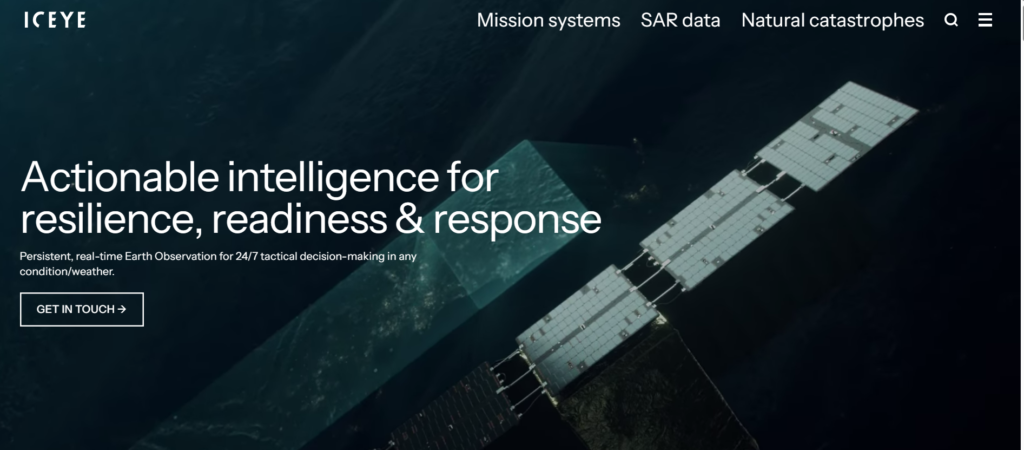
Source: ICEYE
Founded in 2014 by Rafal Modrzewski and Pekka Laurila, ICEYE is a Finnish aerospace company specializing in Synthetic Aperture Radar (SAR) satellite technology. Headquartered in Espoo, Finland, ICEYE operates the world’s largest SAR satellite constellation, capable of imaging any location on Earth, regardless of weather or light conditions. With more than 38 satellites launched as of 2024, ICEYE provides high-frequency, high-resolution data to commercial and government customers across the globe.
Industry Impact
ICEYE’s SAR imaging solutions reshape industries like insurance, disaster management, national defense, and environmental monitoring. Its ability to deliver actionable satellite data within hours of a natural disaster has positioned the company as a critical infrastructure partner for both public agencies and private insurers. In March 2025, ICEYE began supplying SAR imagery directly to NATO’s Situation Centre in Brussels, reinforcing its role in real-time global intelligence.
Key Innovations
1. SAR Microsatellite Constellation
ICEYE’s SAR constellation offers high revisit rates and sub-meter resolution. Its small form-factor satellites are launched in batches and can capture imagery regardless of cloud cover or sunlight.
2. Near Real-Time Flood Monitoring
ICEYE’s flood monitoring platform enables insurers and governments to assess flood extent and depth within hours of an event. This accelerates claims processing and disaster relief.
3. Tasking and Delivery Platform
Customers can directly task satellites and receive imagery through ICEYE’s cloud-based interface. This gives users on-demand, programmable access to Earth observation.
4. Mission-as-a-Service (MaaS)
ICEYE builds and operates custom SAR satellites for clients under its Mission-as-a-Service program. This includes design, manufacturing, launch, and data handling.
Patent Activity
ICEYE holds a strategic portfolio of patents focused on SAR image processing, data transmission, and system optimization. As of 2023, it has had 68 patents filed globally, with 10 granted, many protecting mission-critical SAR technology.
Notable Patents
1. High-Resolution Wide Swath SAR Imaging
Patent Number: 20250060478 – A method of operating a Synthetic Aperture Radar ‘SAR’ to acquire image data of a swath comprising one or more subswath(s).
2. Satellite Operations
Patent Number: 20250047371 – A method of providing Earth observation data comprises: acquiring Earth observation echo data on a first satellite in a low Earth orbit, determining a time required to downlink predetermined data to a ground station on Earth from the first satellite at the current position of the first satellite.
3. Angle-Aware Object Classification
Patent Number: 20240428562 – A computer-implemented method of classifying objects in an image. The method comprises receiving data associated with the image and receiving incidence angle data.
#6. Astroscale
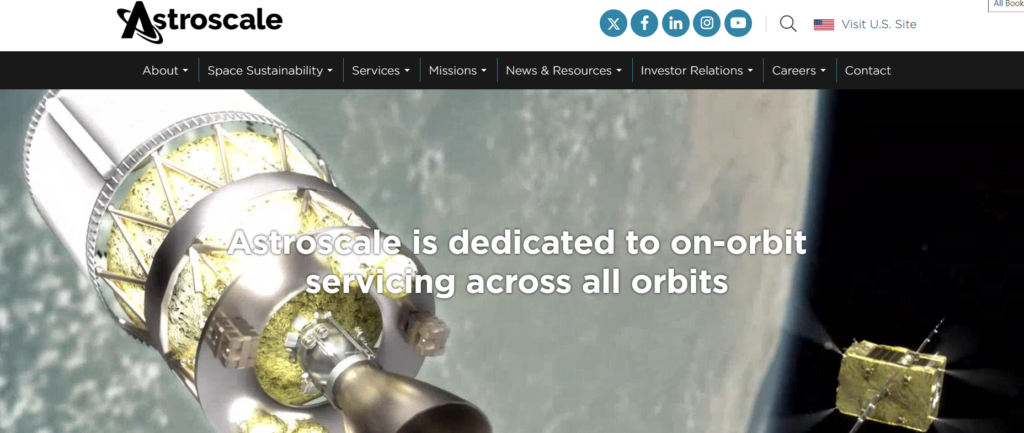
Source: Astroscale
Founded in 2013 by Mitsunobu Okada, Astroscale is a private company dedicated to addressing the growing issue of space debris and ensuring the sustainable use of Earth’s orbits. Headquartered in Tokyo, Japan, with subsidiaries in the United Kingdom, United States, Israel, and Singapore, Astroscale develops innovative solutions for on-orbit servicing, including debris removal, life extension, inspection, and in-space refueling. The company’s mission is to actively contribute to the long-term sustainability of space activities by mitigating the risks posed by defunct satellites and other debris.
Industry Impact
Astroscale is pioneering the space sustainability sector by developing technologies and services aimed at reducing space debris and extending the operational life of satellites. Their efforts are crucial in maintaining the safety and viability of orbital operations, benefiting satellite operators, space agencies, and the broader space industry. By offering commercial debris removal and on-orbit servicing solutions, Astroscale is setting new standards for responsible behavior in space and promoting a circular space economy.
Key Innovations
1. End-of-Life Services by Astroscale-demonstration (ELSA-d)
ELSA-d is the world’s first commercial mission to demonstrate the core technologies necessary for debris docking and removal. Launched in March 2021, the mission consists of a servicer satellite and a client satellite, which perform complex rendezvous and proximity operations to capture simulated debris using a magnetic docking mechanism. In August 2021, ELSA-d successfully released and magnetically recaptured the client satellite, proving key technologies required for capturing orbital debris.
2. Cleaning Outer Space Mission through Innovative Capture (COSMIC)
The COSMIC mission aims to remove two defunct British satellites from orbit, utilizing Astroscale’s expertise in rendezvous and proximity operations (RPO) and robotic debris capture capabilities. Scheduled for launch in the coming years, COSMIC represents a significant step toward operational debris removal services.
3. In-Space Refueling Technologies
Astroscale Japan has been selected to develop and demonstrate in-space refueling technologies under the “Refueling Technology Contributing to Satellite Life Extension” initiative. This project focuses on extending the operational lifespan of satellites by enabling on-orbit refueling, thereby reducing the need for replacement satellites and minimizing space debris.
4. On-Orbit Servicing Interface Technologies
Supported by Japan’s New Energy and Industrial Technology Development Organization (NEDO), Astroscale is advancing on-orbit servicing interface technologies. The project aims to identify and mature key technologies that will contribute to developing the on-orbit servicing market, facilitating satellite servicing and debris removal operations.
Patent Activity
As of 2023, Astroscale has filed a total of 11 patents globally, with none yet granted. Approximately 27% of these patents are active, reflecting the company’s commitment to protecting its innovative technologies in space debris removal and on-orbit servicing.
Notable Patents
1. Space Vehicle and Capture System
Patent Number: US12122540 – This patent describes a space vehicle equipped with a capture system designed to securely attach to and maneuver defunct satellites or debris, facilitating their removal from orbit.
2. Capturing Plate, On-Orbit Device, and Method for Capturing
Patent Number: US10882643 – This patent outlines a capturing plate attached to an on-orbit device, enabling the device to adhere to target objects in space using a bonding component, such as adhesive, to facilitate debris removal.
3. Space Device, Debris Removal System, and Method for Removing Debris
Patent Number: US10464696 – This patent details a space device comprising an adhesion part and a propulsion system, allowing it to adhere to and maneuver space debris to a predetermined target position for removal.
#7. Planet Labs
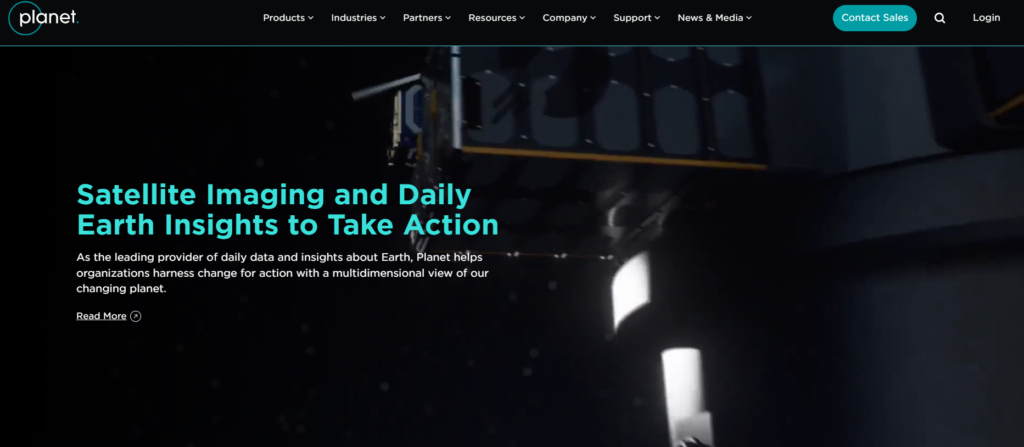
Source: Planet Labs
Founded in 2010 by former NASA scientists Chris Boshuizen, Will Marshall, and Robbie Schingler, Planet Labs PBC is an American earth-imaging company headquartered in San Francisco, California. The company specializes in designing and operating small satellites, known as Doves, which capture high-resolution images of Earth’s surface daily. Planet’s mission is to image the entire Earth’s landmass every day, providing data that supports a wide range of applications, including agriculture, environmental monitoring, urban planning, and disaster response.
Industry Impact
Planet Labs has significantly transformed the Earth observation industry by providing high-frequency satellite data that is commercially accessible. Their constellation of over 200 active satellites enables organizations worldwide to monitor changes on the planet in near real-time. This capability has been instrumental in various sectors, such as agriculture, environmental monitoring, and disaster response.
By democratizing access to daily Earth imagery, Planet Labs empowers various industries and organizations to make informed, data-driven decisions.
Key Innovations
Planet’s Dove satellites are compact, cost-effective CubeSats that capture high-resolution imagery of the earth’s surface. These satellites form the backbone of Planet’s constellation, enabling daily global coverage. Each Dove satellite is equipped with a high-powered telescope and camera programmed to capture different swaths of Earth.
Acquired in 2015, the RapidEye constellation consists of five satellites that provided 5-meter resolution imagery. This addition expanded Planet’s imaging capabilities, particularly in monitoring agricultural lands and forests. The RapidEye satellites were officially retired in April 2020.
Through the acquisition of Terra Bella from Google in 2017, Planet integrated the SkySat constellation into its fleet. These satellites offer sub-meter resolution imagery and high-definition video, enhancing Planet’s ability to serve clients requiring detailed Earth observation data.
Announced in 2022, the upcoming Pelican constellation is designed to succeed the SkySat fleet. It aims to provide higher resolution imagery with increased revisit rates, capturing images up to 30 times per day at mid-latitudes. The first demonstrator satellite, Pelican-1, was launched on November 11, 2023, to validate the satellite platform.
Patent Activity
Planet Labs maintains an active patent portfolio that supports its advancements in satellite technology, imaging systems, and data processing. As of 2024, Planet Labs holds numerous patents in the United States and internationally, covering various aspects of their satellite and imaging technologies.
Notable Patents
1. Systems and Methods for Implementing Time Delay Integration Imaging Techniques
Patent Number: US10958859B2 – This patent outlines systems and methods for implementing time delay integration (TDI) imaging techniques in conjunction with monolithic charge-coupled device (CCD) image sensors having multiple distinct imaging regions.
2. Multi-Pathway Satellite Communication Systems and Methods
Patent Number: US10979137B2 – This patent details systems and methods for controlling satellites, including obtaining requests for image data and selecting communication pathways to transmit image acquisition commands based on request priorities.
#8. Sierra Space
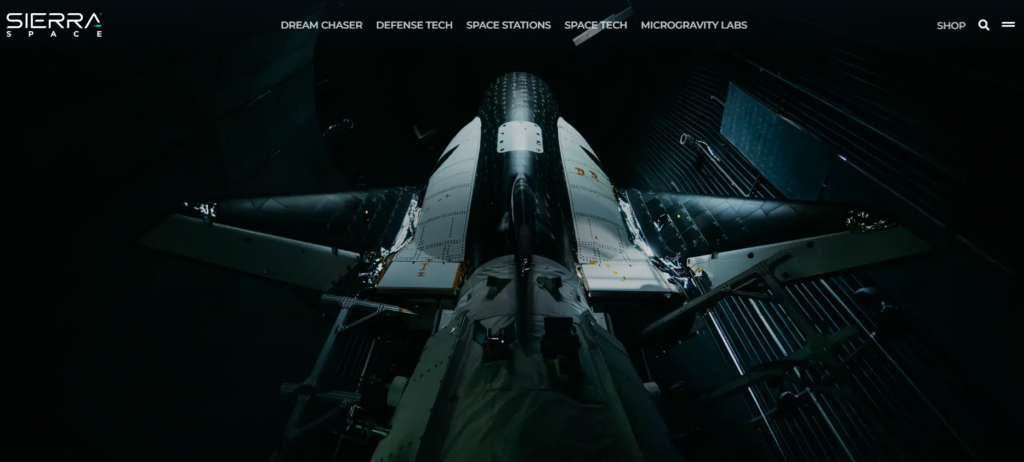
Source: Sierra Space
Sierra Space was founded in 2021 as a commercial space subsidiary of Sierra Nevada Corporation (SNC), a privately held aerospace and defense contractor led by Fatih and Eren Ozmen. Headquartered in Louisville, Colorado, Sierra Space is focused on building the infrastructure for commercial space travel, orbital logistics, and future off-Earth habitation. The company’s flagship projects include the Dream Chaser spaceplane and the LIFE habitat, which are central to NASA’s Commercial Resupply Services and future space station initiatives.
Industry Impact
Sierra Space is revolutionizing space transportation and destination networks, aiming to power the new space economy. By building a shared ecosystem in space for scientific collaboration and innovation, Sierra Space is dedicated to creating a prosperous and secure space economy that will benefit all of humanity.
Key Innovations
The Dream Chaser® is a reusable spaceplane designed to transport cargo and crew to low Earth orbit (LEO). It can land on conventional runways, making it a versatile vehicle for various space missions. The Dream Chaser® has been selected by NASA for cargo delivery, return, and disposal services for the International Space Station under the Commercial Resupply Services 2 (CRS-2) contract.
2. LIFE™ Habitat (Large Inflatable Fabric Environment)
The LIFE™ Habitat is an inflatable modular habitat designed to provide comfortable living and working spaces for astronauts in LEO and beyond. Its expandable structure allows for efficient transportation and deployment, offering a scalable solution for future space stations and deep space missions.
3. Orbital Reef Commercial Space Station
In partnership with Blue Origin, Sierra Space is developing Orbital Reef, a commercially owned and operated space station. Orbital Reef aims to open the next chapter of human space exploration by providing a platform for research, industrial activity, and tourism in LEO.
4. Space Technologies and Components
Sierra Space develops various space technologies and components, including propulsion systems, environmental control and life support systems (ECLSS), and thermal control systems. These technologies are integral to various space missions and contribute to advancing space exploration capabilities.
Patent Activity
As of 2023, Sierra Space holds a total of 71 patents globally, with 32 granted patents.
Notable Patents
1. Liquid Propellant Injector for Vortex Hybrid Rocket Motor
Patent Number: US11952967B2 – Describes various embodiments of a vortex hybrid motor, including a housing with a solid propellant and an injector ring at the proximal end.
2. Hybrid Rocket Oxidizer Flow Control System Including Regression Rate Sensors
Patent Number: US11879414B2 – Details a vortex hybrid motor system comprising a control system, vortex hybrid motor, and oxidizer injector, focusing on flow control and regression rate sensing.
3. Encapsulated Insulation with Uniformly Heated Surfaces
Patent Number: US11827383B2 – Introduces a surface heating device with a heater assembly, dielectric material, thermal insulation, encapsulation layer, and controller for uniform heating.
#9. D-Orbit
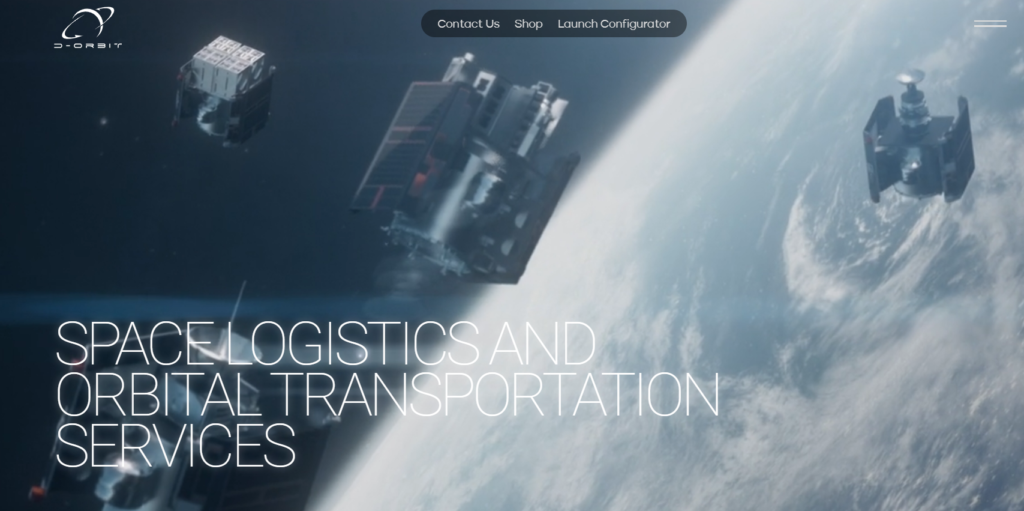
Source: D-Orbit
Founded in 2011 by Luca Rossettini and Renato Panesi, D-Orbit is an Italian aerospace company specializing in space logistics and transportation services. Headquartered in Italy, with subsidiaries in Portugal, the UK, and the US, D-Orbit aims to streamline satellite launch, across-orbit transportation, on-orbit servicing, refueling, and end-of-mission disposal. The company’s mission is to create the first space logistics infrastructure to enable the upcoming trillion-dollar space economy and human expansion in a sustainable space.
Industry Impact
D-Orbit is pioneering the space logistics sector by providing comprehensive solutions that cover the entire lifecycle of a space mission. Their services include last-mile delivery of satellites, orbital transportation, space logistics, mission control as a service, and space waste management. By offering these integrated services, D-Orbit significantly reduces the time and cost associated with deploying and operating satellites, thereby accelerating the growth and development of the space economy.
Key Innovations
The ION Satellite Carrier is D-Orbit’s proprietary orbital transfer vehicle designed to transport and deploy satellites into precise orbital slots. This innovation enables the deployment of multiple satellites in different orbits during a single mission, optimizing the launch process and reducing costs.
2. In-Orbit Servicing and Refueling
D-Orbit is developing technologies for in-orbit servicing, including satellite inspection, repair, and refueling. These services aim to extend the operational life of satellites, reduce space debris, and promote sustainability in space operations.
Addressing the growing concern of space debris, D-Orbit has developed systems for the safe decommissioning and removal of defunct satellites from orbit. Their autonomous decommissioning device ensures that satellites are responsibly disposed of at the end of their operational life, mitigating the risk of collisions and contributing to a sustainable space environment.
D-Orbit offers a cloud-based Mission Control Software suite that provides operators with the tools necessary to manage and monitor satellite missions effectively. This software enhances operational efficiency and provides real-time data analysis for informed decision-making.
Patent Activity
As of 2023, D-Orbit holds a total of 59 patents globally, with 35 granted and over 91% active. These patents encompass various innovations in satellite deployment, in-orbit servicing, and space debris removal technologies.
Notable Patents
1. Method of Releasing Artificial Satellites in Earth’s Orbit
Patent Number: US11673694B2 – This patent describes a method for releasing artificial satellites into Earth’s orbit using an orbital transport spacecraft equipped with a cargo area for sequential satellite deployment.
2. Method for the Safe Release of Artificial Satellites in Earth’s Orbit
Patent Number: US11066194B2 – This patent outlines a method for safely releasing artificial satellites in Earth’s orbit, involving an orbital transport spacecraft with multiple PODs for satellite deployment and a safety subsystem to ensure secure release in case of malfunctions.
#10. Indian Space Research Organisation (ISRO) / NewSpace India Ltd. (NSIL)
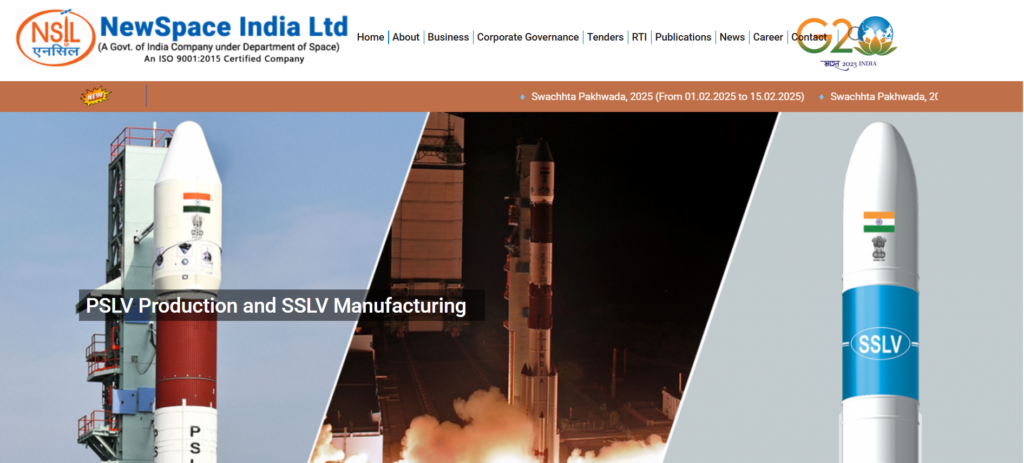
Source: NSIL
The Indian Space Research Organisation (ISRO), established in 1969, is India’s national space agency, headquartered in Bengaluru. ISRO is dedicated to advancing space technology and its applications for national development. In 2019, NewSpace India Ltd. (NSIL) was formed as ISRO’s commercial arm to facilitate the transfer of ISRO’s technologies to the private sector and to promote and commercially exploit products, services, and technologies developed by ISRO.
Industry Impact
ISRO has significantly contributed to India’s emergence as a key player in the global space industry. Its cost-effective and reliable satellite launch capabilities have attracted international clients, positioning India as a competitive launch service provider. ISRO’s initiatives have enhanced telecommunications, weather forecasting, and resource mapping, directly impacting India’s socio-economic development. NSIL complements these efforts by commercializing space products and services, fostering innovation, and encouraging private sector participation in space activities.
Key Innovations
1. Polar Satellite Launch Vehicle (PSLV)
The PSLV is ISRO’s workhorse launch vehicle, renowned for its versatility and reliability in deploying satellites into various orbits. It has successfully launched numerous satellites for both domestic and international clients.
2. Navigation with Indian Constellation (NavIC)
NavIC is India’s independent regional navigation satellite system, providing accurate position information services over India and the surrounding region. It enhances applications in transportation, personal mobility, and resource monitoring.
3. Space Docking Experiment (SpaDeX)
SpaDeX is a mission to develop autonomous docking technology, a critical capability for future crewed missions and space station operations. It involves two spacecraft performing rendezvous and docking maneuvers in orbit.
ISRO has developed various spin-off technologies, including adhesives, thermal barriers, and medical devices like the Left Ventricular Assist Device (LVAD), demonstrating the broader societal benefits of space research.
Patent Activity
ISRO maintains an extensive patent portfolio, reflecting its commitment to innovation in space technology. As of 2024, ISRO holds a total of 589 patents globally, with 408 active patents.
Notable Patents
1. BCH Encoder and method for generating a BCH signal for navigation
Patent Number: 20240063824 – The Embodiment provides a Bose-Chadhuri-Hocquenghem (BCH) encoder for generating a BCH signal. The BCH encoder (1) includes a memory for storing a minimum distance to be used for generating the BCH signal for a BCH code (n, k) and a polynomial generator for generating a generator polynomial for the BCH code (n, k) and encoding the generator polynomial to obtain the BCH signal.
2. A Process for Preparing a Composite Anode for Lithium Ion Cell
Patent Number: 20220294005 – The present application provides a process for preparing a composite anode for a lithium ion cell comprising the steps of: (i) forming an anode slurry in a planetary mixing machine by mixing active materials, a binder and a solvent; (ii) coating the slurry over a copper foil substrate in a coating machine at a speed of 0.3-1.0 m/min; and (iii) calendering of the anode in a calendering machine at a temperature of 50-150° C.
Space Tech is no longer Science-Fiction. It’s Patent-backed Infrastructure
The top 10 space tech companies featured in this article aren’t just launching rockets or satellites; they’re engineering the next phase of civilization. From SpaceX’s fully reusable launch stack to ICEYE’s real-time SAR analytics and Astroscale’s debris-cleaning missions, these organizations are solving the most complex challenges in aerospace, Earth intelligence, and orbital sustainability.
But with so much noise in the sector, how do you separate headline-grabbing stunts from real, defensible innovation?
Patent activity offers the clearest signal.
It reveals who’s building proprietary IP, how problems like lunar landing and in-orbit servicing are being tackled, and where long-term technological bets are being made, from propulsion systems to autonomous satellite tasking.
That’s where the Global Patent Search Tool becomes indispensable. This AI-powered platform helps you:
- Discover related patents by describing your space tech idea in plain language.
- Identify innovations by priority date, inventor, or company.
- Match key components, like docking systems, payload buses, or propulsion modules, to existing patents.
- Analyze how space innovation is evolving across regions, categories, and timeframes.
Whether you’re a space founder, government partner, or aerospace investor, understanding the patent landscape means staying ahead of the orbital innovation curve. Start your next mission with Global Patent Search.

